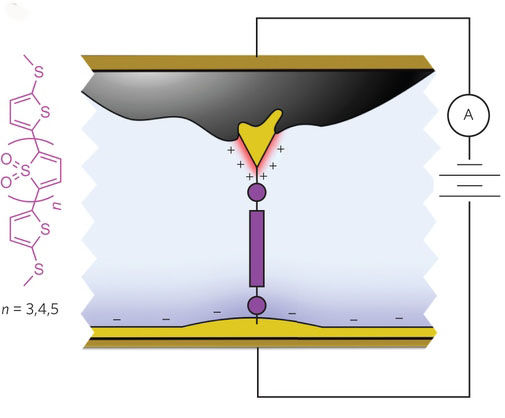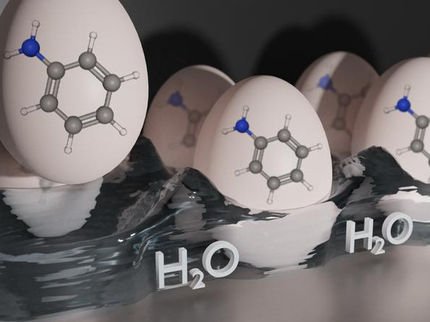Meet the high-performance single-molecule diode
Major milestone in molecular electronics scored by Berkeley Lab and Columbia University team
Researchers at Berkeley Lab and Columbia University has passed a major milestone in molecular electronics with the creation of the world's highest-performance single-molecule diode.The team used a combination of gold electrodes and an ionic solution to create a single-molecule diode that outperforms the best of its predecessors by a factor of 50.

Schematic of the molecular junction created using asymmetric area electrodes which functions as a diode, allowing current to flow in one direction only
Courtesy of Berkeley Lab and Columbia University
"Using a single symmetric molecule, an ionic solution and two gold electrodes of dramatically different exposed surface areas, we were able to create a diode that resulted in a rectification ratio, the ratio of forward to reverse current at fixed voltage, in excess of 200, which is a record for single-molecule devices," says Jeff Neaton, Director of the Molecular Foundry.
A typical diode consists of a silicon p-n junction between a pair of electrodes (anode and cathode) that serves as the "valve" of an electrical circuit, directing the flow of current by allowing it to pass through in only one "forward" direction. The asymmetry of a p-n junction presents the electrons with an "on/off" transport environment. Scientists have previously fashioned single-molecule diodes either through the chemical synthesis of special asymmetric molecules that are analogous to a p-n junction; or through the use of symmetric molecules with different metals as the two electrodes. However, the resulting asymmetric junctions yielded low rectification ratios, and low forward current. Neaton and his colleagues at Columbia University have discovered a way to address both deficiencies.
"The ionic solution, combined with the asymmetry in electrode areas, allows us to control the junction's electrostatic environment simply by changing the bias polarity," Neaton says. "In addition to breaking symmetry, double layers formed by ionic solution also generate dipole differences at the two electrodes, which is the underlying reason behind the asymmetric shift of molecular resonance. The Columbia group's experiments showed that with the same molecule and electrode setup, a non-ionic solution yields no rectification at all."
The Berkeley Lab-Columbia University team believes their new approach to a single-molecule diode provides a general route for tuning nonlinear nanoscale-device phenomena that could be applied to systems beyond single-molecule junctions and two-terminal devices.
Original publication
Most read news
Original publication
Brian Capozzi, Jianlong Xia, Olgun Adak, Emma J. Dell, Zhen-Fei Liu, Jeffrey C. Taylor, Jeffrey B.Neaton, Luis M. Campos & Latha Venkataraman, "Single-molecule diodes with high rectification ratios through environmental control", Nature Nanotechnology, 10, 2015
Organizations
Other news from the department science

Get the chemical industry in your inbox
From now on, don't miss a thing: Our newsletter for the chemical industry, analytics, lab technology and process engineering brings you up to date every Tuesday and Thursday. The latest industry news, product highlights and innovations - compact and easy to understand in your inbox. Researched by us so you don't have to.








![[Fe]-hydrogenase catalysis visualized using para-hydrogen-enhanced nuclear magnetic resonance spectroscopy](https://img.chemie.de/Portal/News/675fd46b9b54f_sBuG8s4sS.png?tr=w-712,h-534,cm-extract,x-0,y-16:n-xl)















































